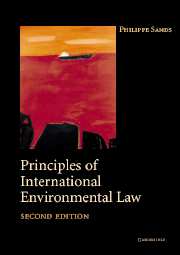Book contents
- Frontmatter
- Contents
- Foreword
- Preface and acknowledgments to the first edition
- Preface and acknowledgments to the second edition
- Table of cases
- Table of treaties and other international instruments
- List of abbreviations
- PART I The legal and institutional framework
- 1 The environment and international society: issues, concepts and definitions
- 2 History
- 3 Governance: states, international organisations and non-state actors
- 4 International law-making and regulation
- 5 Compliance: implementation, enforcement, dispute settlement
- PART II Principles and rules establishing standards
- PART III Techniques for implementing international principles and rules
- Index
3 - Governance: states, international organisations and non-state actors
- Frontmatter
- Contents
- Foreword
- Preface and acknowledgments to the first edition
- Preface and acknowledgments to the second edition
- Table of cases
- Table of treaties and other international instruments
- List of abbreviations
- PART I The legal and institutional framework
- 1 The environment and international society: issues, concepts and definitions
- 2 History
- 3 Governance: states, international organisations and non-state actors
- 4 International law-making and regulation
- 5 Compliance: implementation, enforcement, dispute settlement
- PART II Principles and rules establishing standards
- PART III Techniques for implementing international principles and rules
- Index
Summary
K. Dahlberg, A. Feraru and M. Soroos (eds.), Environment and the Global Arena: Actors, Values, Policies, Futures (1983); P. Sands, ‘The Environment, Community and International Law’, 30 Harvard International Law Journal 393 (1989); P. Sand, Lessons Learned in Global Environmental Governance (1990); J. Tuchman-Mathews (ed.), Preserving the Global Environment: The Challenge of Shared Leadership (1990); A. Hurrell and B. Kingsbury (eds.), The International Politics of the Environment: Actors, Interests and Institutions (1992); Commission on Global Governance, Our Global Neighborhood (1995); K. Ginther, E. Denters and P. De Waart (eds.), Sustainable Development and Good Governance (1995); D. Bodansky, ‘The Legitimacy of International Governance: A Coming Challenge for International Environmental Law?’, 93 AJIL 596 (1999).
Introduction
A wide range of actors participate in those aspects of the international legal order which address environmental issues, including the negotiation, implementation and enforcement of international environmental agreements. Apart from state delegations, which play the central role, a visitor to ozone or climate change negotiations would find international organisations and non-state actors actively involved. International environmental law is characterised by this phenomenon which, with the possible exception of the human rights field, renders it unique. Various reasons explain this state of affairs. States are involved because they are still the pre-eminent international legal persons. International organisations participate because they have been created by states to address particular environmental issues.
- Type
- Chapter
- Information
- Principles of International Environmental Law , pp. 70 - 122Publisher: Cambridge University PressPrint publication year: 2003



